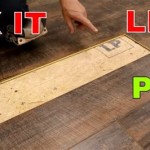How To Remove Linoleum Flooring From Concrete Slab
Removing linoleum flooring from a concrete slab can be a challenging, yet achievable, undertaking. Whether driven by a desire for a renovation, replacement due to wear and tear, or preparation for a new flooring installation, understanding the process and employing the correct tools and techniques is crucial for a successful outcome. This article provides a comprehensive guide to effectively and safely removing linoleum flooring from a concrete slab.
Prior to commencing the removal process, it is imperative to assess the age and composition of the linoleum. Older linoleum, particularly that installed before the 1980s, may contain asbestos. Asbestos is a hazardous material, and disturbing it can release harmful fibers into the air. If there is any suspicion of asbestos content, testing by a qualified professional is strongly recommended. If asbestos is confirmed, professional abatement is necessary to avoid health risks and legal liabilities. Assuming the linoleum is asbestos-free, the removal process can proceed.
Safety should be paramount throughout the removal process. Personal protective equipment (PPE) is essential. This includes safety glasses to protect the eyes from debris, work gloves to prevent cuts and abrasions, and a dust mask or respirator to avoid inhaling dust and potential mold spores. Proper ventilation is also crucial to minimize exposure to airborne particles and adhesive fumes.
Gathering Necessary Tools and Materials
Before starting the removal, compiling the correct tools and materials will streamline the process and improve efficiency. A scraper, either manual or powered, is the primary tool for lifting the linoleum. A manual floor scraper, with a long handle and a replaceable blade, is suitable for smaller areas and intricate work. A powered floor scraper, also known as a demo hammer with a wide scraper attachment, is more efficient for larger areas but requires more caution and control. Other essential tools and materials include:
- Utility knife: For scoring and cutting the linoleum into manageable sections.
- Hammer: For tapping the scraper blade to loosen stubborn areas.
- Putty knife: For scraping away adhesive residue after the linoleum is removed.
- Heat gun or hairdryer: To soften the adhesive and make it easier to remove the linoleum.
- Gloves: To protect hands from adhesives and sharp edges.
- Safety glasses: To protect eyes from flying debris.
- Dust mask or respirator: To prevent inhalation of dust and debris.
- Garbage bags or containers: For disposing of the removed linoleum and debris.
- Floor adhesive remover: To dissolve stubborn adhesive residue (ensure compatibility with concrete).
- Concrete cleaner: For preparing the concrete surface for new flooring.
- Shop vacuum: For cleaning up dust and debris.
- Knee pads: For comfort during extended work on the floor.
- Plastic sheeting: To protect surrounding areas from dust and debris.
- Duct tape: To secure plastic sheeting and for general repairs.
Preparing the Work Area
Proper preparation of the work area is crucial for a safe and efficient removal process. The first step is to clear the room of all furniture and other obstructions. Cover any adjacent areas, such as doorways and walls, with plastic sheeting to prevent dust and debris from spreading. Secure the plastic sheeting with duct tape. Ensure adequate ventilation by opening windows and doors, if weather permits. If using a powered scraper, have access to a power outlet and ensure the cord does not create a tripping hazard.
Before starting to remove the linoleum, inspect the condition of the existing floor. Take note of any areas where the linoleum is particularly well-adhered or where there are signs of damage to the underlying concrete. This will help determine the best approach for removing the linoleum and whether any repairs to the concrete subfloor will be needed later.
The Removal Process: Step-by-Step
The linoleum removal process involves several key steps. The specific techniques employed may vary depending on the type of linoleum, the adhesive used, and the condition of the concrete slab.
Step 1: Scoring and Cutting the Linoleum: Using a utility knife, score the linoleum into manageable sections. The size of the sections will depend on the thickness and flexibility of the linoleum. Smaller sections are generally easier to handle. Make sure to use a sharp blade and apply consistent pressure to ensure a clean cut. Scoring the linoleum helps to prevent it from tearing into smaller, unmanageable pieces during removal.
Step 2: Applying Heat (Optional): If the adhesive is particularly stubborn, apply heat to soften it. Use a heat gun or hairdryer on a low setting and direct the heat onto a small section of the linoleum for a few seconds. Be careful not to overheat the linoleum, as this could damage the concrete or release harmful fumes. Move the heat gun or hairdryer slowly across the surface, keeping it a few inches away from the linoleum.
Step 3: Scraping the Linoleum: Using a floor scraper, begin to lift the linoleum from the concrete slab. Start at a corner or edge and work your way inward. Hold the scraper at a low angle and apply steady pressure. If using a manual scraper, use a hammer to tap the blade to loosen stubborn areas. If using a powered scraper, use a sweeping motion and be careful not to gouge or damage the concrete.
Step 4: Removing Adhesive Residue: After the linoleum has been removed, adhesive residue will likely remain on the concrete slab. This residue needs to be removed to ensure a smooth and level surface for the new flooring. Begin by scraping away as much of the residue as possible with a putty knife. For stubborn residue, apply a floor adhesive remover according to the manufacturer's instructions. Ensure the adhesive remover is compatible with concrete. Allow the remover to sit for the recommended time, then scrape away the softened residue. Multiple applications may be necessary.
Step 5: Cleaning the Concrete Slab: Once the adhesive residue has been removed, thoroughly clean the concrete slab with a concrete cleaner. This will remove any remaining dirt, dust, and debris. Follow the cleaner's instructions for application and rinsing. Allow the concrete slab to dry completely before proceeding with any further steps.
Addressing Common Challenges
Throughout the linoleum removal process, several challenges may arise. Understanding how to address these challenges can save time and frustration.
Extremely Stubborn Adhesive: If the adhesive is particularly difficult to remove, try using a combination of heat, adhesive remover, and a powered scraper. Allow the adhesive remover to soak for a longer period, and consider using a more aggressive scraper blade. In some cases, a specialized adhesive grinder may be necessary.
Damaged Concrete: During the removal process, the concrete slab may become damaged, particularly if a powered scraper is used aggressively. Small chips and cracks can be repaired with a concrete patching compound. Follow the manufacturer's instructions for application and curing. For more extensive damage, professional concrete repair may be required.
Mold Growth: If mold is present under the linoleum, it must be addressed before proceeding with any further work. Mold can be a health hazard, and it's important to take precautions to prevent its spread. Clean the affected area with a mold-killing solution and allow it to dry completely. Consider using a dehumidifier to reduce moisture levels in the area.
Disposal of Linoleum and Waste
Proper disposal of the removed linoleum and waste is crucial. Check local regulations for disposal requirements. Linoleum is generally not recyclable and must be disposed of in a landfill. Ensure that the linoleum is properly contained in garbage bags or containers to prevent it from becoming a hazard during transport. Adhesive removers and other chemicals should be disposed of according to their respective instructions.
Following the linoleum removal and subsequent cleaning, the concrete slab should be carefully inspected to ensure it’s prepared for the new flooring. This includes checking for any cracks, unevenness, or residual adhesive. Addressing these issues prior to installing the new flooring is critical for achieving a long-lasting and professionally finished result.

This Is The Easiest Way To Remove Linoleum Glue From Concrete Hometalk

How To Remove Old Vinyl Or Linoleum Flooring Kitchens And Bathrooms

Easiest Way Of Removing Linoleum From Concrete

How To Easily Remove Linoleum Houseful Of Handmade

How To Remove Linoleum Adhesive From A Concrete Floor

How To Finish Removing Linoleum Adhesive For Tile On Concrete Floor Hometalk

The Fastest Way To Remove Bonded Vinyl Flooring From Concrete

What You Should Know About Removing Old Linoleum Or Vinyl Flooring Hq Longwood Fl

How To Diy Easy Way Remove Linoleum Flooring Off Concrete Slab

How To Remove Linoleum Discount Dumpster Al
Related Posts








